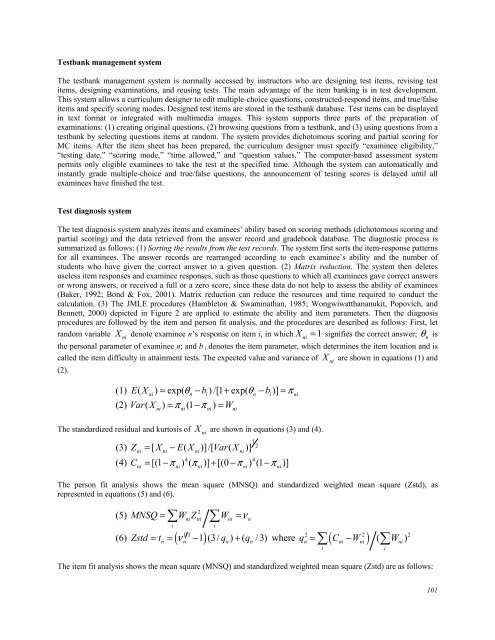October 2007 Volume 10 Number 4 - Educational Technology ...
October 2007 Volume 10 Number 4 - Educational Technology ...
October 2007 Volume 10 Number 4 - Educational Technology ...
You also want an ePaper? Increase the reach of your titles
YUMPU automatically turns print PDFs into web optimized ePapers that Google loves.
Testbank management system<br />
The testbank management system is normally accessed by instructors who are designing test items, revising test<br />
items, designing examinations, and reusing tests. The main advantage of the item banking is in test development.<br />
This system allows a curriculum designer to edit multiple-choice questions, constructed-respond items, and true/false<br />
items and specify scoring modes. Designed test items are stored in the testbank database. Test items can be displayed<br />
in text format or integrated with multimedia images. This system supports three parts of the preparation of<br />
examinations: (1) creating original questions, (2) browsing questions from a testbank, and (3) using questions from a<br />
testbank by selecting questions items at random. The system provides dichotomous scoring and partial scoring for<br />
MC items. After the item sheet has been prepared, the curriculum designer must specify “examinee eligibility,”<br />
“testing date,” “scoring mode,” “time allowed,” and “question values.” The computer-based assessment system<br />
permits only eligible examinees to take the test at the specified time. Although the system can automatically and<br />
instantly grade multiple-choice and true/false questions, the announcement of testing scores is delayed until all<br />
examinees have finished the test.<br />
Test diagnosis system<br />
The test diagnosis system analyzes items and examinees’ ability based on scoring methods (dichotomous scoring and<br />
partial scoring) and the data retrieved from the answer record and gradebook database. The diagnostic process is<br />
summarized as follows: (1) Sorting the results from the test records. The system first sorts the item-response patterns<br />
for all examinees. The answer records are rearranged according to each examinee’s ability and the number of<br />
students who have given the correct answer to a given question. (2) Matrix reduction. The system then deletes<br />
useless item responses and examinee responses, such as those questions to which all examinees gave correct answers<br />
or wrong answers, or received a full or a zero score, since these data do not help to assess the ability of examinees<br />
(Baker, 1992; Bond & Fox, 2001). Matrix reduction can reduce the resources and time required to conduct the<br />
calculation. (3) The JMLE procedures (Hambleton & Swaminathan, 1985; Wongwiwatthananukit, Popovich, and<br />
Bennett, 2000) depicted in Figure 2 are applied to estimate the ability and item parameters. Then the diagnosis<br />
procedures are followed by the item and person fit analysis, and the procedures are described as follows: First, let<br />
random variable X ni denote examinee n’s response on item i, in which X ni = 1 signifies the correct answer; θ n is<br />
the personal parameter of examinee n; and b i denotes the item parameter, which determines the item location and is<br />
called the item difficulty in attainment tests. The expected value and variance of X ni are shown in equations (1) and<br />
(2).<br />
(1) EX ( ni) = exp( θn − bi) /[1+ exp( θn − bi)]<br />
= πni<br />
(2) Var( X ) = π (1 − π ) = W<br />
ni ni ni ni<br />
The standardized residual and kurtosis of X ni are shown in equations (3) and (4).<br />
(3) Zni = [ Xni − E( Xni )]/[ Var( Xni<br />
)]<br />
(4) C<br />
4 4<br />
= [(1 − π ) ( π )] + [(0 −π ) (1 − π )]<br />
ni ni ni ni ni<br />
The person fit analysis shows the mean square (MNSQ) and standardized weighted mean square (Zstd), as<br />
represented in equations (5) and (6).<br />
1 2<br />
2<br />
(5) MNSQ = ∑WniZni ∑ Wni = ν n<br />
i i<br />
13<br />
(6) Zstd = tn = ( ν n − 1(3/ ) qn) + ( qn<br />
/3) where = ∑( − ) ∑<br />
q C W ( W )<br />
2 2 2<br />
n ni ni ni<br />
i i<br />
The item fit analysis shows the mean square (MNSQ) and standardized weighted mean square (Zstd) are as follows:<br />
<strong>10</strong>1

















